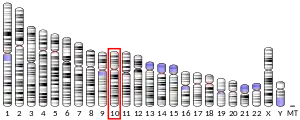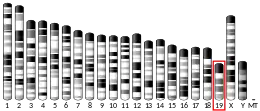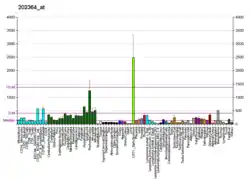MAX-interacting protein 1 is a protein that in humans is encoded by the MXI1 gene.[5][6]
Function
Expression of the c-myc gene, which produces an oncogenic transcription factor, is tightly regulated in normal cells but is frequently deregulated in human cancers. The protein encoded by this gene is a transcriptional repressor thought to negatively regulate MYC function, and is therefore a potential tumor suppressor. This protein inhibits the transcriptional activity of MYC by competing for MAX, another basic helix-loop-helix protein that binds to MYC and is required for its function. Defects in this gene are frequently found in patients with prostate tumors. Three alternatively spliced transcripts encoding different isoforms have been described. Additional alternatively spliced transcripts may exist but the products of these transcripts have not been verified experimentally.[6]
Interactions
MXI1 has been shown to interact with SMC3[7] and MAX.[7][8][9][10][11]
References
- 1 2 3 GRCh38: Ensembl release 89: ENSG00000119950 - Ensembl, May 2017
- 1 2 3 GRCm38: Ensembl release 89: ENSMUSG00000025025 - Ensembl, May 2017
- ↑ "Human PubMed Reference:". National Center for Biotechnology Information, U.S. National Library of Medicine.
- ↑ "Mouse PubMed Reference:". National Center for Biotechnology Information, U.S. National Library of Medicine.
- ↑ Wechsler DS, Hawkins AL, Li X, Jabs EW, Griffin CA, Dang CV (Nov 1994). "Localization of the human Mxi1 transcription factor gene (MXI1) to chromosome 10q24-q25". Genomics. 21 (3): 669–72. doi:10.1006/geno.1994.1336. PMID 7959753.
- 1 2 "Entrez Gene: MXI1 MAX interactor 1".
- 1 2 Gupta K, Anand G, Yin X, Grove L, Prochownik EV (Mar 1998). "Mmip1: a novel leucine zipper protein that reverses the suppressive effects of Mad family members on c-myc". Oncogene. 16 (9): 1149–59. doi:10.1038/sj.onc.1201634. PMID 9528857.
- ↑ Rual JF, Venkatesan K, Hao T, Hirozane-Kishikawa T, Dricot A, Li N, Berriz GF, Gibbons FD, Dreze M, Ayivi-Guedehoussou N, Klitgord N, Simon C, Boxem M, Milstein S, Rosenberg J, Goldberg DS, Zhang LV, Wong SL, Franklin G, Li S, Albala JS, Lim J, Fraughton C, Llamosas E, Cevik S, Bex C, Lamesch P, Sikorski RS, Vandenhaute J, Zoghbi HY, Smolyar A, Bosak S, Sequerra R, Doucette-Stamm L, Cusick ME, Hill DE, Roth FP, Vidal M (Oct 2005). "Towards a proteome-scale map of the human protein-protein interaction network". Nature. 437 (7062): 1173–8. Bibcode:2005Natur.437.1173R. doi:10.1038/nature04209. PMID 16189514. S2CID 4427026.
- ↑ Billin AN, Eilers AL, Queva C, Ayer DE (Dec 1999). "Mlx, a novel Max-like BHLHZip protein that interacts with the Max network of transcription factors". J. Biol. Chem. 274 (51): 36344–50. doi:10.1074/jbc.274.51.36344. PMID 10593926.
- ↑ Meroni G, Reymond A, Alcalay M, Borsani G, Tanigami A, Tonlorenzi R, Lo Nigro C, Messali S, Zollo M, Ledbetter DH, Brent R, Ballabio A, Carrozzo R (May 1997). "Rox, a novel bHLHZip protein expressed in quiescent cells that heterodimerizes with Max, binds a non-canonical E box and acts as a transcriptional repressor". EMBO J. 16 (10): 2892–906. doi:10.1093/emboj/16.10.2892. PMC 1169897. PMID 9184233.
- ↑ FitzGerald MJ, Arsura M, Bellas RE, Yang W, Wu M, Chin L, Mann KK, DePinho RA, Sonenshein GE (Apr 1999). "Differential effects of the widely expressed dMax splice variant of Max on E-box vs initiator element-mediated regulation by c-Myc". Oncogene. 18 (15): 2489–98. doi:10.1038/sj.onc.1202611. PMID 10229200.
Further reading
- Zervos AS, Gyuris J, Brent R (1993). "Mxi1, a protein that specifically interacts with Max to bind Myc-Max recognition sites". Cell. 72 (2): 223–32. doi:10.1016/0092-8674(93)90662-A. PMID 8425219. S2CID 5146555.
- Zervos AS, Gyuris J, Brent R (1994). "Mxi1, a protein that specifically interacts with Max to bind Myc-Max recognition sites" (PDF). Cell. 79 (2): following 388. PMID 7954804. Archived from the original (PDF) on 2011-09-28.
- Schreiber-Agus N, Meng Y, Hoang T, Hou H, Chen K, Greenberg R, Cordon-Cardo C, Lee HW, DePinho RA (1998). "Role of Mxi1 in ageing organ systems and the regulation of normal and neoplastic growth". Nature. 393 (6684): 483–7. Bibcode:1998Natur.393..483S. doi:10.1038/31008. PMID 9624006. S2CID 4387311.
- Eagle LR, Yin X, Brothman AR, Williams BJ, Atkin NB, Prochownik EV (1995). "Mutation of the MXI1 gene in prostate cancer". Nat. Genet. 9 (3): 249–55. doi:10.1038/ng0395-249. PMID 7773287. S2CID 32569637.
- Albarosa R, DiDonato S, Finocchiaro G (1995). "Redefinition of the coding sequence of the MXI1 gene and identification of a polymorphic repeat in the 3' non-coding region that allows the detection of loss of heterozygosity of chromosome 10q25 in glioblastomas". Hum. Genet. 95 (6): 709–11. doi:10.1007/BF00209493. PMID 7789959. S2CID 303145.
- Schreiber-Agus N, Chin L, Chen K, Torres R, Rao G, Guida P, Skoultchi AI, DePinho RA (1995). "An amino-terminal domain of Mxi1 mediates anti-Myc oncogenic activity and interacts with a homolog of the yeast transcriptional repressor SIN3". Cell. 80 (5): 777–86. doi:10.1016/0092-8674(95)90356-9. PMID 7889571. S2CID 6210262.
- Edelhoff S, Ayer DE, Zervos AS, Steingrímsson E, Jenkins NA, Copeland NG, Eisenman RN, Brent R, Disteche CM (1994). "Mapping of two genes encoding members of a distinct subfamily of MAX interacting proteins: MAD to human chromosome 2 and mouse chromosome 6, and MXI1 to human chromosome 10 and mouse chromosome 19". Oncogene. 9 (2): 665–8. PMID 8290278.
- Wechsler DS, Shelly CA, Dang CV (1997). "Genomic organization of human MXI1, a putative tumor suppressor gene". Genomics. 32 (3): 466–70. doi:10.1006/geno.1996.0144. PMID 8838813.
- Bonaldo MF, Lennon G, Soares MB (1997). "Normalization and subtraction: two approaches to facilitate gene discovery". Genome Res. 6 (9): 791–806. doi:10.1101/gr.6.9.791. PMID 8889548.
- Shimizu E, Shirasawa H, Kodama K, Sato T, Simizu B (1997). "Expression, regulation and polymorphism of the mxi1 genes". Gene. 176 (1–2): 45–8. doi:10.1016/0378-1119(96)00206-5. PMID 8918230.
- Gupta K, Anand G, Yin X, Grove L, Prochownik EV (1998). "Mmip1: a novel leucine zipper protein that reverses the suppressive effects of Mad family members on c-myc". Oncogene. 16 (9): 1149–59. doi:10.1038/sj.onc.1201634. PMID 9528857.
- Prochownik EV, Eagle Grove L, Deubler D, Zhu XL, Stephenson RA, Rohr LR, Yin X, Brothman AR (1999). "Commonly occurring loss and mutation of the MXI1 gene in prostate cancer". Genes Chromosomes Cancer. 22 (4): 295–304. doi:10.1002/(SICI)1098-2264(199808)22:4<295::AID-GCC5>3.0.CO;2-Q. PMID 9669667. S2CID 34743689.
- Li XJ, Wang DY, Zhu Y, Guo RJ, Wang XD, Lubomir K, Mukai K, Sasaki H, Yoshida H, Oka T, Machinami R, Shinmura K, Tanaka M, Sugimura H (1999). "Mxi1 mutations in human neurofibrosarcomas". Jpn. J. Cancer Res. 90 (7): 740–6. doi:10.1111/j.1349-7006.1999.tb00809.x. PMC 5926139. PMID 10470286.
- Benson LQ, Coon MR, Krueger LM, Han GC, Sarnaik AA, Wechsler DS (1999). "Expression of MXI1, a Myc antagonist, is regulated by Sp1 and AP2". J. Biol. Chem. 274 (40): 28794–802. doi:10.1074/jbc.274.40.28794. PMID 10497252.
- Taj MM, Tawil RJ, Engstrom LD, Zeng Z, Hwang C, Sanda MG, Wechsler DS (2001). "Mxi1, a Myc antagonist, suppresses proliferation of DU145 human prostate cells" (PDF). Prostate. 47 (3): 194–204. doi:10.1002/pros.1063. hdl:2027.42/34758. PMID 11351349. S2CID 27372396.
- Yin X, Landay MF, Han W, Levitan ES, Watkins SC, Levenson RM, Farkas DL, Prochownik EV (2001). "Dynamic in vivo interactions among Myc network members". Oncogene. 20 (34): 4650–64. doi:10.1038/sj.onc.1204606. PMID 11498788.
- Manni I, Tunici P, Cirenei N, Albarosa R, Colombo BM, Roz L, Sacchi A, Piaggio G, Finocchiaro G (2002). "Mxi1 inhibits the proliferation of U87 glioma cells through down-regulation of cyclin B1 gene expression". Br. J. Cancer. 86 (3): 477–84. doi:10.1038/sj.bjc.6600065. PMC 2375210. PMID 11875718.
- Ariyanayagam-Baksh SM, Baksh FK, Swalsky PA, Finkelstein SD (2004). "Loss of heterozygosity in the MXI1 gene is a frequent occurrence in melanoma". Mod. Pathol. 16 (10): 992–5. doi:10.1097/01.MP.0000087421.44975.1C. PMID 14559981.
External links
- MXI1+protein,+human at the U.S. National Library of Medicine Medical Subject Headings (MeSH)
- FactorBook Mxi1
This article incorporates text from the United States National Library of Medicine, which is in the public domain.




